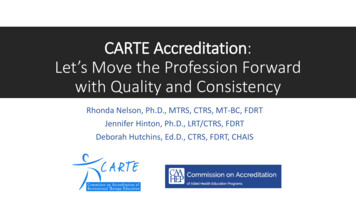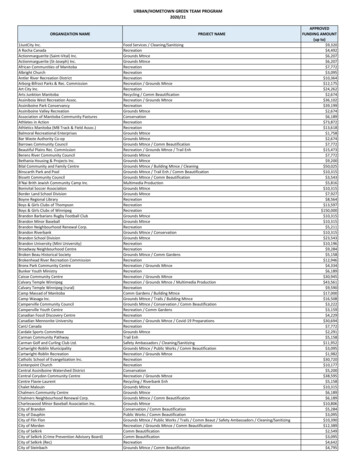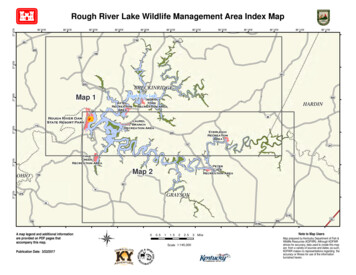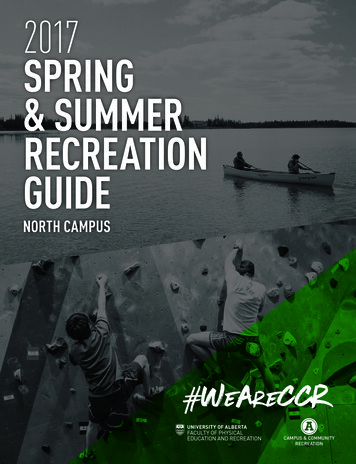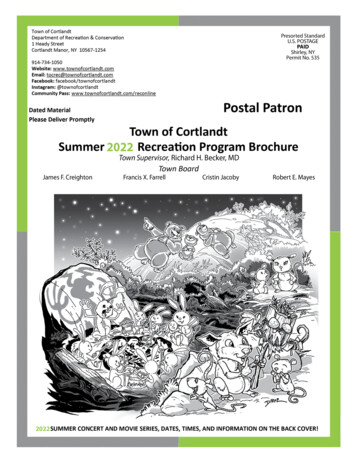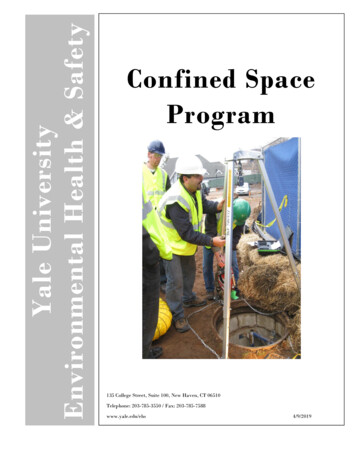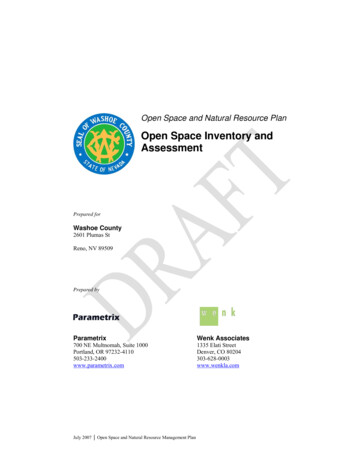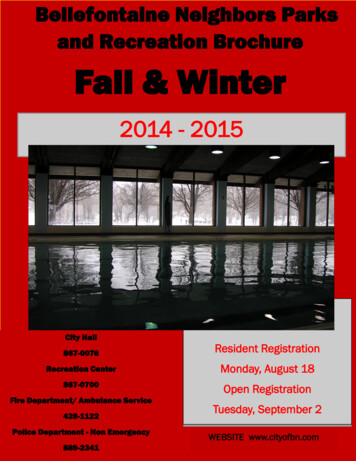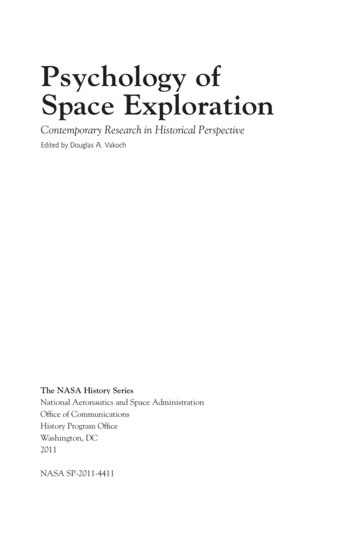
Transcription
Open Space and Recreation Planfor the Town of HamiltonSecond Update and RevisionTown of Hamilton MassachusettsTown Hall577 Bay RoadPO Box 429Hamilton, MA 01936September 2015
Plan Summary:Section 1 Plan Summary . 1-1Section 2 Introduction . 2-1A Statement of Purpose . 2-1B Planning Process and Public Participation . 2-2Section 3 COMMUNITY SETTING . 3-1A Regional Context . 3-1General Physical Location . 3-1Resources Shared With Neighboring Towns . 3-3Socio-Economic Context . 3-13B History of the Community. 3-14C Population Characteristics . 3-17Population Density. 3-17Family Income . 3-17Industries . 3-17D Growth and Development Patterns . 3-17Patterns And Trends . 3-17Infrastructure . 3-17Long-term Planning Patterns . 3-17Section 4 ENVIRONMENTAL INVENTORY AND ANALYSIS . 4-17A Geology, Soils, and Topography . 4-17Description . 4-17Geology and soils in Hamilton wetlands and floodplains . 4-17Effects on Community . 4-17B Landscape Character . 4-17C Water Resources . 4-17Flood Hazard Areas . 4-17Wetlands . 4-17Aquifer Recharge Areas . 4-17D Vegetation . 4-17E Fisheries and Wildlife . 4-17F Scenic Resources and Unique Environments . 4-17G Environmental Problems . 4-17Section 5 INVENTORY OF LANDS OF CONSERVATION INTEREST . 5-17A Protected Parcels . 5-17Bradley Palmer State Park . 5-17Willowdale Mill . 5-17Appleton Farm . 5-17Ipswich River Wildlife Sanctuary . 5-17Fee-simple lands of Essex County Greenbelt Association . 5-17iiComment [J1]: I have not re-formatted the TOC
Plan Summary:Hamilton-Wenham Open Land Trust . 5-17Town of Hamilton Water Supply Lands . 5-17Chebacco Woods . 5-17Town of Manchester-by-the-Sea Lands . 5-17Harvard Forest. 5-17Public Lands protected by Conservation Restrictions . 5-17Private Lands protected by Conservation Restrictions . 5-179B Unprotected parcels . 5-11Miscellaneous town holdings . 5-17U.S. Air Force . 5-11Other significant unprotected parcels. 5-11Chapter 61, 61A and 61B Lands – As of Jan. 2007, assessors records show anadditional 270 acres for which a simplified list as below has not yet been compiled. .5-12Section 6 COMMUNITY GOALS . 6-17A Description of Process . 6-17B Statement of Open Space and Recreation Goals . 6-17Section 7 ANALYSIS OF NEEDS . 7-17A Summary of Resource Protection Needs . 7-17B Summary of Community’s Needs . 7-17Growth management strategies. 7-17Action on housing . 7-17Reproduction of the Questionnaire, with summary of responses. 7-17Part III.Open Space, Recreation & Historic Preservation . 7-17Part IV.Growth Management . 7-17Part V. Housing . 7-17Part VI. Community Facilities and Services . 7-17C Management Needs, Potential Change of Use . 7-17Management needs . 7-17Potential change of use . 7-17Section 8 GOALS AND OBJECTIVES . 8-17Section 9 Town of Hamilton Open Space Five-Year Action Plan . 9-17Section 10Public Comments. 10-17Section 11Maps . 11-17Section 12References . 12-17OPEN SPACE. 12-17Section 13Town of Hamilton Americans with Disabilities Act Information . 13-17A Town Office of Disabilities Commission . 13-17B Town Section 504 Coordinator . 13-17ii
Plan Summary:C Documentary exhibits on Americans With Disabilities Act Compliance in Townof Hamilton . 13-17Exhibit 1 - TOWN OF HAMILTON ADA SECTION 504 . 13-17Exhibit 2 - PERSONNEL BYLAW SECTION 13.01: Occupational Sick Leave . 13-17Exhibit 3 - SECTION 13.02: Non-Occupational Sick Leave . 13-17Exhibit 4 - Personnel By-law SECTION 13.05: Family Medical Leave . 13-17Exhibit 5 - Personnel By-law Section 14.01 Death in the Family: Paid Leave . 13-17Exhibit 6 - Text of Sample Employment Announcement/Advertisement . 13-17Exhibit 7 - Personnel By-law Section 5.03: Medical Examination of Job Applicants. .13-17Exhibit 8 - Employment Application . 13-17Exhibit 9 - Personnel By-law Section 15.01: Personnel Grievances . 13-17Exhibit 10 - Department of Public Works - ACSFME labor contract Article 3Discrimination and Coercion . 13-17Exhibit 11 - Department of Public Works - ACSFME labor contract Article 12Grievance and Arbitration Procedure . 13-17Exhibit 12 - Police Union labor contract. Article 18 Grievance Procedure . 13-17Exhibit 13 - Town Hall Union contract. Article 11 Grievance and ArbitrationProcedure . 13-17Exhibit 14 - Town Hall Union contract. Article 26 Compliance with the AmericansWith Disabilities Act . 13-17Exhibit 15 - Emergency Center Dispatcher contract. Article 10 Grievance andArbitration Procedure. 13-17Exhibit 16 - Emergency Center Dispatcher contract. Article 25 Compliance withAmericans with Disabilities Act . 13-174
Plan Summary:SECTION 1PLAN SUMMARYHamilton’s history is that of a rural town, one in which the stewardshipof land for agriculture, equestrian use, and passive enjoyment of nature andwildlife has been a primary factor in shaping its character. Although the townfunctions as a residential suburb to Boston and the North Shore and the Route128 urbanized areas, preservation of its remaining rural character is a highpriority. This theme dominates both the original 1965 Master Plan for Hamilton,authored by the renowned planner Charles Eliot, and its recently updatedversion, as well as successive Open Space and Recreation Plans, including thisone.The preparation of this plan involved: Updating inventory of open space resources, specialnatural features, and cultural resources of the town; Analyzing the challenges to maintaining thesevalues. Formulating a five-year action plan to evaluatepriorities regarding current open space goals. Thisplan focuses on assuring reasonable and vibrantprotection for the valued open spaces.This should include priority needs and recommended actions/projects. It can be included at the end of theprocess, once public input has been received.1-1
COMMUNITY SETTING:SECTION 2INTRODUCTIONAStatement of PurposeIn answer to the often-asked question “What is open space?”the Town recognizes that the interests protected by Article97 of the Commonwealth of Massachusetts Constitution andguaranteed to the people of Massachusetts as constitutionalrights should be considered in determining what parcels toprioritize for protection. These interests include biodiversityand habitat protection, water resources protection,preservation of working and historic farms, preservation ofscenic vistas, and passive-use recreation. These prioritieshave been adopted pursuant to the constitutional provisionsby the Executive Office of Energy and EnvironmentalAffairs (EEA) and emphasize preservation of naturalresources and the ability of the public to enjoy thosepreserved natural areas.The Town supports the agency in its statement that “We mustbe careful, however, not to view open space solely as amechanism against growth. In Massachusetts, our landscapeencourages the natural and built environments to work inunison, not against one another. This model creates a unique,vibrant and healthy place to live, work, play and visit.”In evaluating open space parcels for preservation, this Plannotes that our town already has a great deal of open spacethat is permanently protected. In two areas of town, roughlyat the eastern and western extremities, there are largeamounts of open space that are contiguous to similarquantities of open space in neighboring towns. Theseconnections form large wildlife corridors, and providesignificant watershed protection. They include severalworking farms and forests, some of which provideexceptional passive recreational resources.Hamilton’s open space and recreation plan is not intended topromote or prevent development, to provide municipalrevenue, or to determine land use. Rather, this plan shouldact as a guide to preserving the various resources under the2-1
COMMUNITY SETTING:open space and recreation umbrella while Hamilton continuesto grow and change.This should include citation of significant acquisitions, other protections, projects or policy changes sincethe last plan.BPlanning Process and PublicParticipationThis update of the Hamilton Open Space and Recreation Planwas developed by Town Hall staff and consultants. The Drafts ofthis Plan was were presented to groups of citizens at two publicforums on (insert dates). The town ‘s consultant also solicited inputregarding current needs and opportunities from stakeholdergroups including volunteer boards and committees, recreationservice providers, trail users, and resource preservationorganizations. The Draft Plan was also posted at the Town website.Comments were invited at both the forums and through thewebsite via email. All comments have been logged and respondedto by staff. This is included as an Appendix to the Plan.Comment [J2]: verify with dates etc.The format of this plan conforms to the specifications set forthby the Commonwealth of Massachusetts Division ofConservation Services (DCS).SECTION 3COMMUNITY SETTINGARegional ContextGeneral Physical LocationHamilton is located in Boston’s North Shore region in EssexCounty, Massachusetts. The Ipswich River forms the northernboundary between Hamilton and the Town of Ipswich.Hamilton is bordered by Essex to the east, Wenham to thesouth and Topsfield to the west, with Manchester touching thesoutheast corner of Town. See “Location map of Hamilton”, inthe map section.The center of Hamilton is approximately 27 miles by road3-1Comment [J3]: Yellow highlights mean thathighlighted text needs to be verified as properlylabeled in the appendixes of updated version; andyellow highlights also point out the tables need tobe updated
COMMUNITY SETTING:from the State House in Boston. Routes 128 and I-95,important commuter highways in the Boston metropolitanregion, are located a few miles from Hamilton’s borders. TheNewburyport line of the commuter rail system connects SouthHamilton with Newburyport, Ipswich, Beverly, Salem, andBoston. Beverly Airport is convenient for recreational flyingand corporate aircraft. Proximity to transportation corridors,scenic amenities and a reputation for fine schools have madeHamilton an attractive “bedroom community” forprofessionals working in Boston, Beverly, Salem, and Route128 technical and industrial firms.Though sections of Hamilton possess suburban characteristics,it would be inaccurate to classify Hamilton as merely anotherBoston suburb. The handsome Historic District and severallarge tracts of forest and agricultural lands contribute toHamilton’s “small town” New England feeling. Some of theseopen lands are protected from development by conservationrestrictions or by inclusion in state parks or nature preservesowned by environmental organizations. However some of thetown’s remaining open land is fully developable shouldcurrent private owners decide to sell.The North Shore’s trails, lakes, beaches and marinas affordmany opportunities for outdoor recreation. Hamilton residentscan make use of ocean beaches and marinas outside of Townborders. Hamilton’s trail system is a recreational resource ofimmense value to horseback riders, hikers, cross- countryskiers and mountain bikers.The Ipswich River offers historical (the location of the oldWillowdale mill , now an ECGA reservation), and recreational(canoeing, swimming and fishing) as well as natural (animal,plant and fish habitat) value. Other local waterways of interestare the Miles River, Wenham Swamp and Wenham Lake.Hamilton features a plentiful supply of freshwater resources.The Ipswich River, the Miles River, and its tributaries includingBlack Brook, plus Chebacco Lake and Beck’s Pond, allundoubtedly aided the farmers in Hamilton’s early history, thedevelopment of the town as a recreational area was alsodependent on the existence of these waters. Today the pondsand streams remain an integral part of the scenic quality whichdraws people to the area.4-1Comment [J4]: “Non-Hamilton” text has beenredacted; this is a brief example of what the type oftext I have deleted. If typically OSRP’s includeregional data the we can out this stuff back in IdeidtedComment [SB5]: Shared resources should be innext section , which is required.
COMMUNITY SETTING:Resources Shared With Neighboring TownsNatural resource areas, and particularly water resources, areno respecters of town boundaries, so although this documentis centered on Hamilton, it is evident throughout that ourresources and open spaces interact with those of neighboringtowns, and in the case of the Ipswich River, even far awaytowns.The Ipswich River is approximately 35 miles long and itswatershed covers about 155 square miles, extending from theWilmington-Reading area inland to the sea at Ipswich. Thesurface and groundwater resources of the basin areintensively used for public water supply (see Table 3-1 TownsDrawing Municipal Water From Ipswich River basin).Table 3-1Towns Drawing Municipal Water From Ipswich River basinBeverlyDanversHamiltonLynnMiddletonNorth nChebacco Lake is a key recreation and water resource forEssex as well as Hamilton. Manchester owns and uses waterresources in Hamilton. Hamilton, Wenham, and Topsfield allhave parts of the Great Wenham Swamp wetlands systemwithin their boundaries. Clearly, resource and recreationplanning for our town must be to a great extent regionalplanning as well.Hamilton shares many active and passive recreation municipalresources with other North Shore communities. (Only a briefsummary will be given here; for a more detailed account seethe “2001 2012 Recreation Master Plan”.) Within Hamilton thereis Patton Park which consists of 15.5 acres of open space. ThePark is located on Route 1A close to the police and fire stationand business center of town. The following activities at thepark are used by both Hamilton and Wenham residents and its5-1Comment [J6]: Is this section necessary understate rules?Comment [SB7]: Yes, the State will look for thisinformation.Comment [J8]: I suppose it doesn’t hurt toinclude this. We DO have concerns with the regionalvs. municipal character of the issues surroundingthe River
COMMUNITY SETTING:out-of-town visitors. Regulation baseball diamond (Youth Leagues, men’ssoftball, senior league baseball, girls’ softball,women’s softball, and intertown baseball) Little League diamond Horseshoe pit (multitown tournaments) A new municipal swimming facility is proposed forPatton Park which will be completed within the fiveyear term of this updated edition of the OSRP.Comment [J9]: Do we need to confirm which ofthese features are on Myopia land and if they willsurvive pool construction?Other Patton Park facilities that are shared by othercommunities include the recently expanded and improvedchildren’s play area, the skating at Weaver Pond, the picnic area(which has grills and benches), the basketball court, and thetennis courts. Both courts have municipal lighting for night timeuse. Lastly, children of all ages come from all over to climbaboard the famous olive-drab Patton tank that sits in the middleof the Park. Summer concerts at the Patton Park bandstand atthe gazebo are open to all.At the Recreation Center, located adjacent to the HamiltonWenham Public Library on Union Street, programs held in thegym for Hamilton and Wenham residents of all ages includeyouth basketball, gymnastics, beano, badminton, seniorcitizens aerobics, and adult volleyball. The Recreation Center’splaying fields are used for U6 and U8 soccer and HamiltonWenham High School field hockey.Bradley Palmer State Park is an important regional recreationand open space resource that is partially in Hamilton.Comment [J10]: Regional trails redactions hereThe Road Safety CommitteeComment [SB11]: I would include a little aboutthis important trail sytem, maybe approximate milesand what they can be used for.Discover Hamilton Trail.The Discover Hamilton Trail is a 10-mile long trail that links agreenway in the Town of Hamilton with the Bay Circuit Trailin Ipswich and the Hamilton Historic District. Open spaceparcels include the Appleton Farms Grass Rides, BradleyPalmer State Park, Harvard Forest, Pingree Reservation, andWillowdale Mill Reservation.Comment [J12]: The Road Safety Comm. nolonger exists. As far as I know their Master Planwent not much further than the planning stage thenext several pages of text from 2009 update aredevoted to the RSC and Master Plan of Road Safety,I’ve stricken them.Trail MapsBelow is a list of free trail maps available to the hiker tonavigate the maze of trails through Hamilton:6-1
COMMUNITY SETTING:Hamilton –Wenham Trails Map. Available at Town Hall andthe Hamilton –Wenham Public Library.Bradley Palmer State Park Trail Map. Available at ParkHeadquarters, located off Asbury Street.Bradley Palmer State Park Self-Guided Nature Trail Map. Alsoavailable at Park Headquarters.Appleton Farms – Hamilton and Ipswich, Massachusetts. Mapavailable at the Highland Avenue Trail Head in Hamilton.Chebacco Woods Trail Map. Available at the Trail Headlocated on Chebacco Road in Hamilton.Border to Boston Rail Trail. Map available fromMassBike/North Shore, P.O. Box 308, Hathorne, MA 01937.Bay Circuit Trail. Map available from the Bay Circuit Alliance,3 Railroad Street, Andover, MA 01810.Socio-Economic ContextAccording to the latest data from the US Census most Hamiltonadult residents (94.0%) have graduated from high school and52.5% have earned a college diploma. A large percentage ofemployed persons (see Table 3-2, Employment) are employedin professional/managerial positions (62.2%, up from 54% in2000). Median family income increased from 28,272 (1980) to 55,101 (1990) to 72,000 (2000) to 117,458 (2013); 12.7% ofhouseholds had an income of 150,000 or more, down from17.5% in (2000). Household characteristics reported: families(80.5%), with children under 18 (40.2%), with persons over 65(24.8%); an average household size of 2.83, and a poverty levelof 2.5 percent.Table 3-2 Employment (U.S. Census, American Community Survey, 5year Estimates, 2009-2013)Employment%Management, businesss, science and arts62.2%Sales and office22.8%Service7.7%Production, transportation and material moving3.o%Natural resources, construction and maintenance4.3%Self-employed9.0%Total number of civilian employed persons3,9987-1Comment [J13]: Very limited quantities of theseremain
COMMUNITY SETTING:BHistory of the CommunityThe Town of Hamilton was settled by farmers who tilled thefields to the south of Ipswich. Early settlers in Hamilton askedthat their local church be “set off” from Ipswich due to thedistance that the community in the “Hamlet” had to travel todowntown Ipswich for church. The forty families within thetown did not find enough room for them at the Wenhamchurch located to the south and decided to build their ownchurch in 1713. After the Revolutionary War, they petitionedto separate into their own community. Finally in 1793,Hamilton became a town. The farms were originally scatteredalong early roads.A representative view of Hamilton in the early 19th century isgiven by the following figures from an agricultural censusdone by the state in 1831.1831 Land useUse483724% 80875.810.371.484.27AcresTillageEnglish and upland mowing, Inclusiveof orchard mowingFresh meadowPasture, inclusive of orchard pastureWood-land, exclusive of enclosedpasture lotsUnimprovedParsonageRoadsWaterTotalThe total is about 18% short of accounting for the actual areaof the town, but the proportions are probably roughly correct.Note that pasturage plus land in the production of fodder isthe predominant land use, totaling about 70%, and woodland,at 12%, is much less.PopulationYear18101820Population7808028-1
COMMUNITY SETTING:1830748Structures, 1831Dwelling HousesShopsBarns11650114Trades, 1831ShopkeepersShoemaking establishmentsSaw mill3About 351Grist millCabinet sCarpentersWeavers1211222811831 Agricultural produceGrainCrop lish and upland hayFresh meadowLivestockHorses 1 yrOxen 4 yr911689-1Tons354416
COMMUNITY SETTING:Cows 3 yrSteers 1yr Sheep 6mo Swine 6mo 399238430139This period represents roughly the peak of agricultural landuse in southern New England. 1830 records at Harvard Forestin Petersham, MA show that nearly all of Hamilton was101
COMMUNITY SETTING:deforested and in pasture or crops, except for the southeasterncorner (around Beck Pond and Round Pond, present dayChebacco Woods and environs), the Great Wenham Swamp inthe southwest of town, an area around Brown’s Hill and anarea near Cutler Pond. All the other forested parts of town arepostagricultural.By 1894, the railroad, (allowing easier access to informationand traveling), the Industrial Revolution (encouraging theabandonment of rocky New England soils where machineswere of little help), and the separation of church and state(decreasing community spirit) had all changed the fabric ofmany New England towns, but Hamilton managed tomaintain its agricultural base. The early maps indicate that anincreased number of smaller farms were now lining the roads.Many of these clustered farmsites also housed shoe shopswhich employed farm workers during the winter as well asfull-time workers.The town of Hamilton experienced the influence of industrialor mill life with the presence of the Willowdale Mill, locatedon the Ipswich River. When the mill closed due to a fire in1884, the population of the town decreased by 100 people. Afew of the mill dwellings were relocated to Mill Street near thecenter of town. Many of the farmers who abandoned theirfarms gained employment through millwork and were able tokeep their farmsteads. Due to the loss of employmentopportunities with the closing of the mill, many finallyabandoned their farms and moved to the industrial cities or toricher farmland in the West.By 1859, Asbury Grove, a 100 acre religious retreat, included300 cottages, a chapel, tabernacle, hotel, spur railroad stationand post office. Many of the gingerbread style cottages wereburned in the fire of 1927 and were never replaced.While Asbury Grove was the first summer community tolocate in Hamilton, Myopia Hunt Club was certainly the mostsignificant. After the near-sighted friends (hence the name)moved their club from Winchester to Hamilton in 1891,wealthy Victorians began purchasing declining agriculturalland for their country estates and summer homes, thereby111
COMMUNITY SETTING:preserving the rural quality of the area. Some moved thecolonial homes back off the main street for privacy and addedbarns, pools
by the Commonwealth of Massachusetts Division of Conservation Services (DCS). SECTION 3 COMMUNITY SETTING A Regional Context General Physical Location Hamilton is located in Boston's North Shore region in Essex County, Massachusetts. The Ipswich River forms the northern boundary between Hamilton and the Town of Ipswich.
